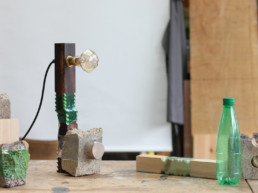February 25, 2018
This is Micaella Pedros: Joining DIscarded Bottles in her Community Project
The designer used a heat gun to warm the PET plastic, which shrinks at a temperature of 300 degrees Celsius as the molecules move closer together. the strength of the plastic joints depends on the shapes of the objects being linked and also on the grooves in the wood. Deeper ridges allow the plastic to form a stronger hold, and stop the separate parts from moving and weakening the joint.
“15 Sept. 2017 – 21 Jan. 2018
Exhibition Pure Gold: upcycled, upgraded, curated by IFA At Museum für Kunst und Gewerbe, Hamburg, Germany”
Joining Bottles: A Social Project
Micaella Pedros is a social and humanitarian product designer driven by the topics of energy, empowerment and culture.
Through design, she seeks to contribute to society by unveiling ways to play and benefit from local resources and natural forces in order to empower people. Inspired by the values of democratic design and do-it-yourself culture, she truly developed her practice and philosophy during her volunteering experience in Uganda in 2014 and her work/travel in Guatemala in 2015.
She obtained her Master’s Degree in Design Product at the Royal College of Art in 2016 and is currently based in London.
Website: Joining Bottles

“Masterclass: Build a Stone Lamp
Monday, May 08, 2017 10:30am – 3:30pm”
— Institute of Making —

joining bottles is an experimental wood-joining technique using shrunk plastic bottles. by heat, a simple plastic bottle is transformed into a wood bonding material offering a meaningful and accessible way to build functional structures.

Both materials, wood and plastic bottles, are widely abundant in cities and other places. There are lying there as waste, waiting to be reclaimed by people. Joining Bottles seeks to contribute to new beliefs based on what we, as individuals and communities, can do with what is available to us. In some countries, this project can make a real difference, promoting the collect of plastic bottles and wood waste, and helping people to empower themselves.
The technique can adapt itself to different shapes which allows to compose structures from any appropriate found materials. The different types of wood and plastic bottles available are dictating the final aspect and composition of the work. In that sense, a unique conversation is engaged within each piece. It creates more space for randomness and spontaneity, in other words, for human attributes in the creative process.







